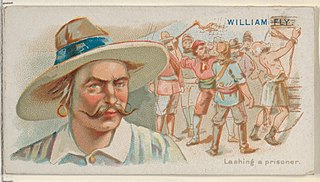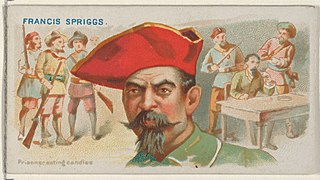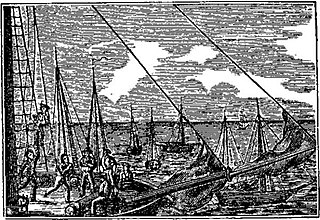Related Research Articles

Jolly Roger is the traditional English name for the ensign flown to identify a pirate ship preceding or during an attack, during the early 18th century. The vast majority of such flags flew the motif of a human skull, or “Death's Head”, often accompanied by other elements, on a black field, sometimes called the "Death's Head flag" or just the "black flag".

Bartholomew Roberts, born John Roberts, was a Welsh pirate who was, measured by vessels captured, the most successful pirate of the Golden Age of Piracy. During his piratical career, he took over 400 prize ships, although most were mere fishing boats. Roberts raided ships off the Americas and the West African coast between 1719 and 1722; he is also noted for creating his own pirate code, and adopting an early variant of the Skull and Crossbones flag.

William Fly was an English pirate who raided New England shipping fleets for three months in 1726 until he was captured by the crew of a seized ship. He was hanged in Boston, Massachusetts, and his body publicly exhibited in a gibbet as a warning to other pirates. His death is considered by many to mark the end of the Golden Age of Piracy.

A castaway is a person who is cast adrift or ashore. While the situation usually happens after a shipwreck, some people voluntarily stay behind on a desert island, either to evade captors or the world in general. A person may also be left ashore as punishment (marooned).
Philip Ashton (1702—1746) was a castaway on then-uninhabited Roatán island in the Gulf of Honduras for 16 months in 1723/1724. His memoirs about his solitary stay were published in book form in Boston in 1725. While some people believed it was a novel in the style of Robinson Crusoe (1719), Ashton's book was the account of a genuine experience. He was born in Marblehead, Massachusetts in 1702 and married twice.

Edward Low was a pirate of English origin during the latter days of the Golden Age of Piracy, in the early 18th century. Low was born into poverty in Westminster, London, and was a thief from an early age. He moved to Boston, Massachusetts, as a young man. His wife died in childbirth in late 1719. Two years later, he became a pirate, operating off the coasts of New England and the Azores, and in the Caribbean.

George Lowther was an English pirate who, although little is known of his life, was reportedly active in the Caribbean and Atlantic during the early 18th century. His first mate was Edward Low.

A pirate code, pirate articles, or articles of agreement were a code of conduct for governing ships of pirates, notably between the 17th and 18th centuries, during the so-called "Golden Age of Piracy". The typical pirate crew was an unorthodox mixture of former sailors, escaped convicts, disillusioned men, and possibly escapee or former slaves, among others, looking for wealth at any cost; once aboard a seafaring vessel, the group would draw-up their own ship- and crew-specific code, which listed and described the crew's policies surrounding pirate behavior and the associated disciplinary action, should a code be violated. Failing to honor the code could get a pirate marooned, whipped, beaten, or even executed. For less serious violations, a pirate may have been temporarily denied equal food rations, or made to clean or maintain parts of the ship for a time. Primarily, these articles were designed to keep order aboard the ship, avoid dissension or mutinies, and ensure the crews' loyalty, all of which was crucial to the group's mutual survival.

Francis Spriggs was a British pirate who, associated with George Lowther and Edward Low, was active in the Caribbean and the Bay of Honduras during the early 1720s.

James Gilliam, or James Kelly was an English pirate and buccaneer active off the coasts of Spanish South and Central America and later in the Indian Ocean. He sailed under several different pirate captains but is best remembered for his brief association with William Kidd.
Charles Harris was an English pirate active in the 1720s. He is best known for his association with George Lowther and Edward Low.

John Phillips was an English pirate captain. He started his piratical career in 1721 under Thomas Anstis, and stole his own pirate vessel in 1723. He died in a surprise attack by his own prisoners. He is noted for the articles of his ship, the Revenge, one of only a few complete sets of pirate articles to survive from the so-called Golden Age of Piracy.

John Martel was a French pirate active in the Caribbean.

Philip Lyne was a pirate known for his cruelty and his association with Francis Spriggs.
Joseph Cooper was a pirate active in the Caribbean and the American east coast. He was best known for sailing alongside Francis Spriggs, and for the manner of his death.
Thomas White was an English pirate active in the Caribbean and the Indian Ocean. He was only briefly a captain on his own, but served under several more prominent captains such as George Booth, John Bowen, Thomas Howard, John Halsey, and Nathaniel North.
Robert Sample was a pirate active off the coast of Africa and in the Caribbean. He is best known for sailing with Edward England.
Robert Lane was a pirate active in the Caribbean and off the coast of Africa. He is best known for sailing with Edward England.

William Lewis was a pirate supposedly active in the Caribbean, off the American east coast, and off the west coast of Africa in the 18th century. He was known for sparing his victims and for being killed after announcing he had made a pact with the Devil. He is likely the fictional creation of "Captain Charles Johnson" who presented his story among those of real historical pirates.

John Russell was a pirate active from Nova Scotia to the Caribbean to the African coast. He is best known for his association with Edward Low and Francis Spriggs, and for his involvement with two well-known and well-documented maroonings.
References
- ↑ Flemming, Gregory N. (2014). At the Point of a Cutlass: The Pirate Capture, Bold Escape, and Lonely Exile of Philip Ashton. Lebanon NH: ForeEdge. ISBN 9781611685626 . Retrieved 3 October 2017.
- 1 2 3 Dow, George Francis; Edmonds, John Henry (1923). The Pirates of the New England Coast, 1630-1730. New York: Courier Corporation. p. 217. ISBN 9780486290645 . Retrieved 5 June 2017.
- 1 2 Flemming, Gregory N. (2014). At the Point of a Cutlass: The Pirate Capture, Bold Escape, and Lonely Exile of Philip Ashton. Lebanon NH: ForeEdge. ISBN 9781611685626 . Retrieved 5 June 2017.
- 1 2 3 Kazerooni, Bijan (2016). "Voces Novae: Chapman University Historical Review". Journals.chapman.edu. 8 (1): 88. Retrieved 5 June 2017.
- 1 2 "Pirate Hold: Pirates". piratehold.com. Retrieved 5 June 2017.
- 1 2 Earle, Peter (2013). The Pirate Wars. London: Macmillan. p. 205. ISBN 9781466849075 . Retrieved 5 June 2017.
- 1 2 3 Gosse, Philip (1924). The Pirates' Who's Who. New York: Burt Franklin. Retrieved 5 June 2017.
- ↑ Ellms, Charles (1837). The Pirates Own Book . Retrieved 5 June 2017.
- ↑ "Greg Flemming - Map" . Retrieved 5 June 2017.
- ↑ Ossian, Rob. "Francis Spriggs". www.thepirateking.com. Retrieved 13 June 2017.
- ↑ Boyer, A. (1726). The Political state of Great Britain. London: A. Boyer. p. 641. Retrieved 22 June 2017.
- ↑ Leeson, Peter (2009). "The Invisible Hook" (PDF). NYU Journal of Law and Liberty. 4: 155. Retrieved 5 June 2017.
